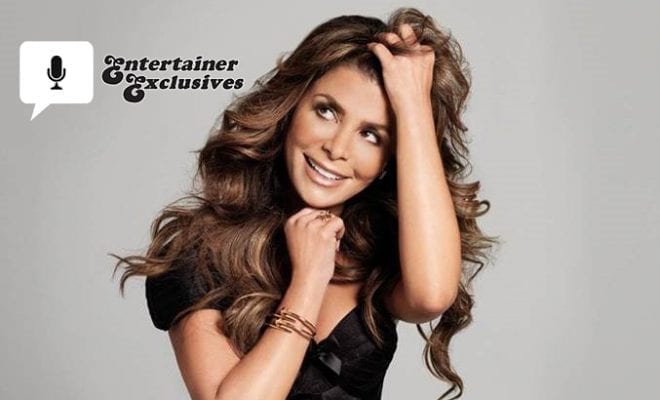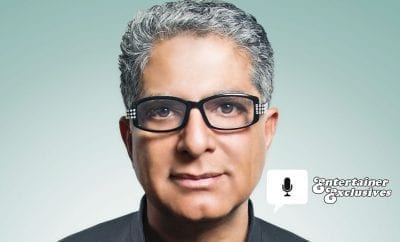 Photo Credit: Studio 10 Australia
Photo Credit: Studio 10 Australia
Music
Entertainer Exclusive Part 1: Inside the Heart of a Pop Music Legend, Paula Abdul
On October 3rd, Paula Abdul hit the road on her North American tour; a tour that’s been more than twenty-five years in the making, since her 1992 Under My Spell tour which grossed $60 million in ticket sales (a mint by 1992 standards), yet also yielded some tragedy that almost sidelined the beloved performer forever. The world knows Paula at the plucky, iconic dancer and popstar turned American Idol judge, turned legacy performer. What people may not know is that this Grammy-winning legend had to climb a mountain of adversity, both physical and emotional, to dance again.
For Abdul, this 2018 Straight Up Paula! tour is a miracle in the making. When audiences come out to see her this fall, they will bear witness to one of the greatest comeback stories in show business history. Because of Abdul’s preference for handling tough times privately, our conversation may shock you, and it will also make you root for her. Abdul’s imitable strength is in her refusal to allow her story to end with tragedy. She insisted on a second act with her long-running stint on American Idol as the judge with heart, to Simon Cowell’s stone-cold blunt criticisms of aspiring vocalists. The show introduced her to a new generation of fans. Her Straight Up Paula! tour is a triumphant third act where she’ll share, not only her catalog of music and iconic choreography, but her surprisingly poignant life story.
Beyond singing and dancing, it was Abdul’s million-dollar smile, huge heart, and humble responses during interviews that captured the publics’ affections and helped to define an entire generation. Beginning with her first #1 hit, Straight Up, in 1988, Paula Abdul was a Gen X darling of epic proportions. She brought something new and engaging to the mix, matching meticulous dance choreography with pop music.
Paula Abdul’s warmth and accessible appeal made an entire generation smitten. As someone put it to me recently, “She could have been your best friend’s sister, your cute neighbor… the girl next door you just had to get to know.”
AK: You’ve said that when it comes to your choreography, you would often dream the dance steps up in your mind, and then you would run to the bathroom mirror and go through the steps that you’d already envisioned. I find that so interesting because that’s how I write. I write by either talking to myself or thinking out loud, whatever you want to call it (laughs); or by having these inspired thoughts that come into my awareness. I’ll then rush over to the computer and type it all out. By the time I get to my computer, it’s already written, just like by the time you get to that mirror the choreography is already done.
PA: Exactly the same!
AK: Do you feel that when it comes to your choreography, it’s being channeled through you, like it’s coming from some higher source? Because that’s how I often feel…
PA: Yes, that completely makes sense to me, because sometimes I’ll even question myself, like, “Where did that idea come from?” It’s really strange, but sometimes I can be in this zone where it feels like auto-pilot, and I’m not even aware of it. It’s kind of cool.
AK: I remember reading something your mom said years ago, about you being four or five years old and declaring that you were meant to be a dancer; something to that effect. When did you start taking dancing lessons?
PA: I started taking dancing lessons at seven, but I was four years old when I walked up to the TV set and told my family, “I’m going to do that,” and it was while watching Gene Kelly in Singing in the Rain.
AK: Well, I remember your mom telling a story about a night when it was raining so hard outside that she couldn’t bring you to your dance class, and you were hysterical crying. The thought of missing a dance class was just devastating to you. Did you actually feel from that very young age that dancing is what you were put on this earth to do?
PA: I absolutely did feel that way. I knew what my calling was. It’s very interesting because I find that with dance, for many young kids, it’s just like that. I hear from so many parents that their daughter, that’s all she does. She does her studies, but she takes six classes a week and can’t bear the thought of not being able to make it through a class. Dance can strike a chord in your heart unlike anything else. It gets into your soul and it changes people’s lives. It’s been [therapeutic] for me, and for most people who dance. I hear so many of the same stories.
AK: Is there anything else you feel you are still here to accomplish or experience, that has yet to be done?
PA: I really want to do some more producing, both in television and film. I’d also like to do some more acting, something that is completely against type. I think it would be more challenging and fun, and it allows you to explore in a way where most people have no idea that a character like that can be within you.
AK: Let’s talk about your tour, Straight Up Paula!. Are you going to make each song’s choreography and costumes reminiscent of the original music videos, or will you change it up to reflect present day?
PA: It will be a little of both. I know that fans come to hear those songs, and they will, but I’m not doing a direct replication of those [music] videos. There is a nod to them, with a little bit of nostalgia. But for me, this is an opportunity to create my own vision of what I want to do in terms of interpreting the songs. I’m incorporating lots of technology and multimedia, and with some storytelling as well. I’m also going to cover some fun things, and some not so fun things, from my life in this show. It’s giving people a little bit more insight into who I am, and the career I’ve had.
AK: Going back to what we were talking about before, about being in the zone, how do you know when you’re in that zone and your creativity is flowing; versus when it feels forced?
PA: For me, there is such a difference when there is a flow. Eight or nine hours can go by, and I can’t even believe it. And then there are times when it seems like the day will never end. I’ve learned that when the latter is happening, I have to do an abrupt about-face and change the environment; step outside, do some other activity to wipe the slate clean. When you’re hitting a wall, it’s stagnant energy. It’s not creative, and it’s not conducive to rehearsal hall or anything else I’m trying to accomplish. For me, muscle memory is now a tricky thing. Your brain also, in terms of remembering, it’s different now. Things that were natural in my body, from so many years of injuries, I need to re-address certain dance moves and change it to what feels better for me now.
AK: When you were talking about time flying by, or crawling by, it reminds me of what Deepak Chopra says about time not really existing, except in our minds. If you’re in the zone, you lose track of time and nine hours feels like nine minutes.
PA: And it’s the best feeling, I’m sure you know! I can’t stand the latter, when time crawls. It’s the worst. You want to just cancel the day and start fresh the next day.
AK: I always say that if you are in a creative field, it’s an odd thing, because you can’t just clock in and clock out. You have to be in a certain creative flow or nothing much is going to happen. Sometimes the best thing you can do when you feel that way is to not work.
PA: It’s true, because it’s more of a wasted day, and it’s miserable (laughs).
AK: I ask this question of everyone, because I learn so much about people through this question… when you pray, who or what do you pray to?
Read Part 2 of our Exclusive Interview with Paula Abdul here
For dates and tickets to Paula Abdul’s North American Tour, Straight Up Paula!, click here. Tickets also available through Ticketmaster.





0 comments